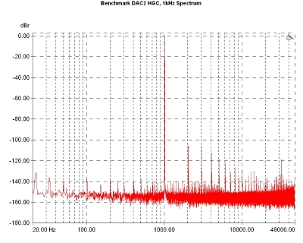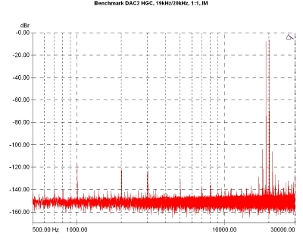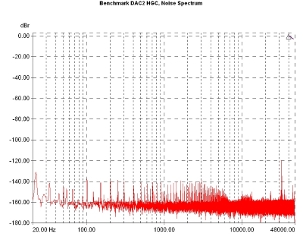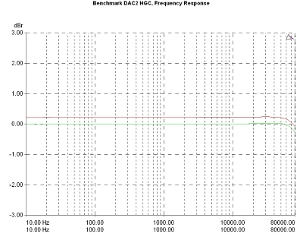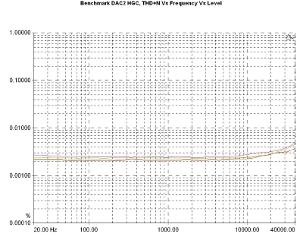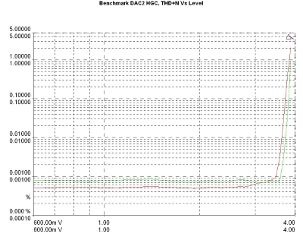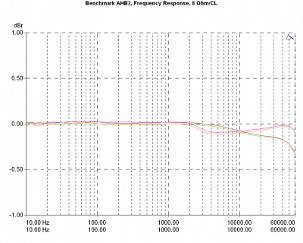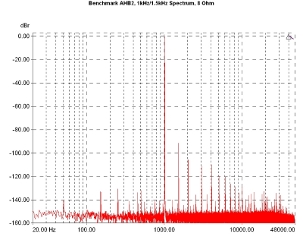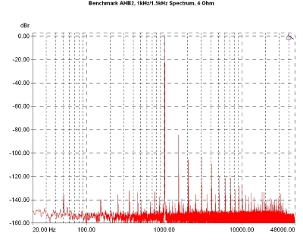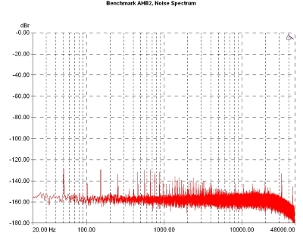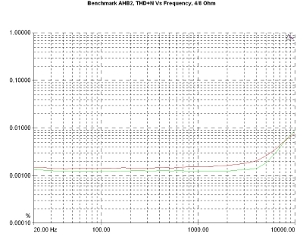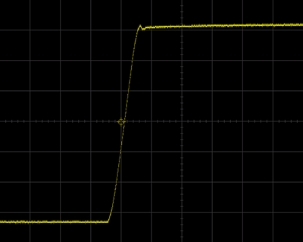about Audio, High Fidelity
& Home Entertainment technologies
pid: 607-2025/10/01 (v1.2)
Privacy Policy
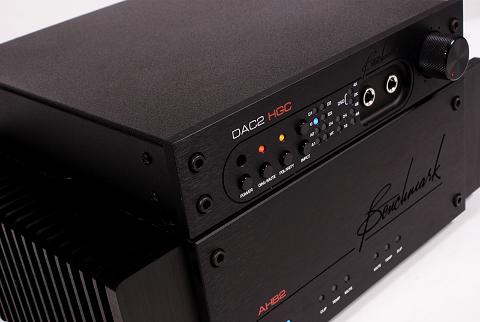
The following DAC2 HGC lab evaluation refers solely to its analog part, used when the device functions as a line-level preamplifier. A detailed evaluation for the DAC2 as a D/A converter can be found here (in Greek language).
Generally, DAC2 HGC offered a very high level of performance, with very low distortion. We measured 0.001% (THD + N) and 0.0005% (THD) for 1Vrms/1kHz output and the intermodulation distortion was also equally low, about 0.0006% (IMD/SMPTE). Signal to noise ratio exceeded -110dBr (A) (-113.29dBr (A) with a reference level of 1Vrms, to be exact) and dynamic range reached -125dB. Based on this performance, the device is not at all far from a very good preamplifier, on the contrary, in many cases appeared to be almost an order of magnitude "down" in distortion figures! One, probably, could wish for a higher output clipping point (clipping starts to occur at around 3.8Vrms) but this does not appear to be a real problem with most amplifiers (including AHB2) whose sensitivity is 2V, or even lower. (An update here: The 3.8Vrms clipping point refers to the single ended output of the DAC2. Its XLR output offers a much higher clipping point, the relevant measurement was about 23.1Vrms. The maximum output, obviously, depends on the on-board attenuator settings. When a DAC2 drives an AHB2, Benchmark suggests to set the preamp's attenuator at the "0dB" point and the power amp's sensitivity to 22dBu. In this case, AHB2 needs 9.8Vrms to deliver its full power). Channel crosstalk was very good, at -84.3dBr (with a 10kHz signal) confirming that we are dealing with a careful implementation both in mechanical and electrical aspects. Volume tracking (the equality of level attenuation between the two channels versus the attenuator control position) was reasonably satisfactory: Difference between the two channels was in the 0.2-0.1dB interval for the most part of the attenuator range and a higher tracking error of about 0.8dB appeared only towards large attenuation values (around and below the "9 o'clock" position). This behavior is quite consistent with Benchmark's recommendation that all sensitivity settings (both for the balanced and the headphone output) should be made so that, for a normal listening level, the attenuator knob is roughly between 10 and 2 o'clock.
Output spectrum for a 1kHz signal includes a number of harmonics, all of them well below -100dBr, with a high reduction rate below -120dBr, a level which is reached after the fifth harmonic.
Intermodulation products are similarly low, with all of the relevant components below -100dBr.
Spectrum analysis with 1kHz signal input. Reference level: 1Vrms.
IMD spectrum analysis. Two-tone, 19/20kHz, 1:1 level ratio signal. Reference level: 1Vrms.
The noise spectrum shows that the DAC2 HGC is indeed a very quiet device without problems of interference or hum. The relevant graph includes a series of visible noise components (from the power supply and in the very high-frequency part of the spectrum), but their level is very low to practically affect DAC2's performance.
Frequency response is flat across the entire range of measurement without a visible cut-off towards the lower frequencies, and with a rather mild roll-off at very high frequencies close to 80kHz.The differences between the two channels are small, in the range of 0.2dB.
Noise spectrum. Reference level: 1Vrms, input shorted.
Frequency response for both channels. Reference level (0dBr): 1Vrms.
The THD+N Vs Frequency graph does not hide any unpleasant surprises. The curves (for an output level of 1Vrms) are below 0.003% with an apparent increasing trend from the 10kHz upwards but with minimal level-depended variation, an indication for a good analog stage design.
This behavior is even more clear in the THD+N Vs Level graph where the relevant curves remain around and below the 0.001% value, up to the overload limit level, just over 3.5Vrms.
THD+N as a function of signal frequency and output level. Reference level (0dBr): 1Vrms. Levels -10dBr (green curve), -7dBr (red), -4dBr (orange), -1dBr (violet).
THD+N as a function of the output level, signal frequency 1kHz.
AHB2's output power, near its clipping limit, was measured at 108Wrms per channel into 8 Ohm loads and at 190Wrms per channel at 4 Ohm loads, easily confirming the specs given by the company itself. Based on this performance, the amplifier seems more than capable of driving difficult loads. Damping factor was estimated above 200, therefore, no system frequency response discrepancies, due to loudspeaker's impedance variability, should be expected.
In distortion measurements, AHB2's behavior was impressive with a total harmonic distortion and noise (THD+N) figure at 0.0009% for 8 Ohm loads and 0.0012% for 4 Ohm loads (measured at 1/3 of its maximum power) and harmonic distortion at 0.0005% and 0.0009% for 8 and 4 Ohm loads respectively. Intermodulation distortion (SMPTE) was also low, at 0.0005% and 0.0007% (8/4 Ohm loads). This performance clearly shows that the Benchmark/THX design approach works in practice as intended (at least from the distortion point of view) and the result is a power stage with very low distortion, indeed. The noise performance of the amplifier was, also, top-class. With a reference level corresponding to 1Wmrs/8 Ohm, the signal to noise ratio was measured at -109dBr (A) (with a 1kHz input signal) and the dynamic range at 129dB.
The frequency response of the amplifier (with an 8 Ohm load) was practically flat with a slight attenuation towards the high-frequency part of the spectrum which is very progressive and does not exceed 0.3dBr at 60kHz. Note that the vertical resolution in the relevant diagram is quite high. When the amplifier drives complex loads, its frequency response is, actually, changing for the better, with variations not exceeding 0.1dBr. Channel balance was, simply, exemplary.
Output spectrum of a 1kHz/1.5kHz (L/R) signal, at 1/3 of the amp's maximum power and with an 8 Ohm load includes the expected number of harmonics at very low levels (all of them under the -100dBr limit). Channel crosstalk (as showed from the 1.5kHz signal leakage) is close to -90dBr, a value which could be regarded as a very good performance.
Frequency response for both channels. Reference level: 1/3 of maximum power in 8-Ohm load, (green/red curve), and in complex (simulated loudspeaker) load (orange/magenta).
Spectrum analysis with 1kHz/1.5kHz input signal. Reference level: 1/3 of maximum power in 8-Ohm load
The amplifier's spectral behavior does not seem to change significantly with a 4-Ohm load at its outputs. There is a marginal increase in the odd-order harmonic content but with the third harmonic below -100dBr and the other harmonics below the -120dBr. In both spectrum graphs, there is an apparent absence of noise components from the power supply and their intermodulation products in the low-frequency range (the 50Hz component is hardly distinguishable), all of them being below -130dBr. This is a remarkable behavior, especially with the output stage under load conditions, which justifies the choice of a switch-mode power supply.
Noise spectrum (in reference to a 1Wrms/8 Ohm output level) confirms the very good static (i.e not through a frequency sweep) noise measurements. Discrete noise components level is extremely low and an absence of high-frequency interference near the upper-frequency limit is, also, quite obvious. Based on these data, one concludes that, indeed, the switch-mode power supply used, imposes no burden on the amp's behavior. On the contrary, one would say, it appears to be a substantially better choice than many linear designs been tested.
Spectrum analysis with 1kHz/1.5kHz input signal. Reference level: 1/3 of maximum power in 4-Ohm load.
Noise spectrum. Reference level: 1Wrms in 8-Ohm load, input shorted.
THD+N Vs Frequency variability is minimal up to about 4kHz where the measured values are almost constantly in the range of 0.001% both in 8 Ohm and 4 Ohm driving conditions. This stable and load-independent behavior of the output stage is something not often encountered and adds, of course, another positive point for the device. Above 4kHz, a slightly upward trend appears, but with the distortion to not exceed the 0.008% up to the measurement limit.
The stable distortion behavior is, also, apparent in the way that THD+N figure varies as a function of output power. Here, the output stage remains persistently around 0.001%, at least up to the point where the overload at both 8 Ohm and 4 Ohm loading conditions is reached.
THD+N as a function of frequency at 1/3 of maximum power in 8-Ohm load (green curve) and 4-Ohm load (red).
THD+N as a function of the output power. 1kHz input signal in 8-Ohm (green curve) and 4-Ohm (red) load.
Finally, the square wave response shows a very good transient behavior, without any particular problem. Slew rate was estimated at 16V/uS and rise time at 3.5mS, a value that corresponds to a conventionally calculated bandwidth of 100kHz.
1kHz square wave response. Maximum output voltage in 8-Ohm load. Horizontal axis: 5uS/Div, vertical axis: 10V/Div.
Previous | Next | More Reviews

